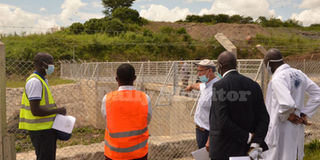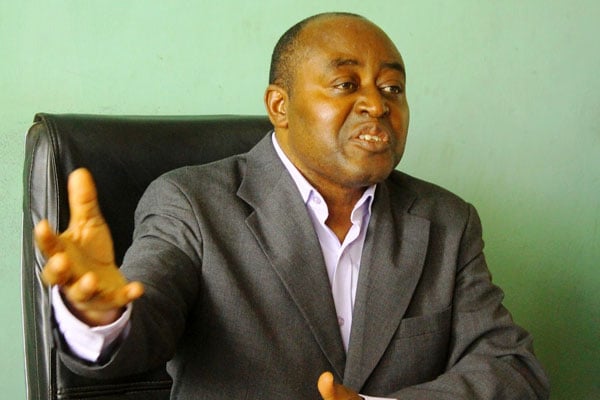NWSC to draw water for Gulu City from Karuma

Dr Silver Mugisha, the NWSC managing director (2nd left), with other officials during a tour of the water in-take plant near Karuma Bridge in Oyam District last year. PHOTO/ TOBBIAS JOLLY OWINY
What you need to know:
- Water will be drawn from River Nile, treated on-site, and pumped up to Gulu City via a 72-km pipe system once the project is done.
The management of National Water and Sewerage Corporation (NWSC) branch in Gulu City have secured a contractor to build an underground pipe system from Karuma Town to Gulu City.
Without giving details of the company, Mr Ivan Tekakwo, the corporation’s regional spokesperson for Gulu station, told this newspaper last Friday that paper work was in the final stages.
“The contractor for the first part of Phase II of the “Integrated Programme to Improve the Living Conditions in Gulu” project has already been identified and they will construct a water treatment plant that will be able to treat 10m litres per day,” Mr Tekakwo said.
“Once that is complete, they will then embark on the pipe system to deliver the water from Karuma,” he added.
Mr Tekakwo said the Shs83.3b project, which is expected to be complete in 2024, will have a reservoir with a holding capacity of 5.3million litres at Custom Corner. It is being funded by the World Bank and KFW Development Bank.
He said once the phase is done, water will be drawn from River Nile, treated on-site, and pumped up to Gulu City via a 72-km pipe system.
“Besides serving Gulu City, the corporation intends to build water plants at six different town boards (Karuma, Kamdini, Minakulu, Bobi, Palenga, and Koro) along the 72 km stretch of the pipe system,” Mr Tekakwo said.
The work was supposed to start last year but delayed due to Covid-19 restrictions.
Mr Tekakwo said the government aims at improving access to clean water and sanitation services in Gulu City, adding that the area has been facing persistent water shortages, especially during the dry season.
When NWSC managing director Silver Mugisha visited the Acholi Sub-region mid last year to assess the works, the construction of the water intake facility on River Nile was pending electromechanical installations.
“The only challenges are only a few technical clichés such as power outages that affect our operating systems and we are working with Umeme to rectify it. Water supply has become very reliable in the city with more than 10,000 clients connected to the supply across the city,” Mr Tekakwo added.
The current water demands in the city are estimated at approximately 6 to 7 million litres per day.
During the first phase, the city’s challenge of sewage overflows was also solved.
Besides upgrading the old 14km sewage network, an additional 7km of sewage lines was added to the network.
In 2017, NWSC started building a faecal sludge treatment plant at Pece-Lokung village in Gulu town dedicated to the treatment of sludge from the septic tanks, sewerage lines, and pit latrines from communities within the city.
The sewage treatment plant is part of the Shs42 billion Gulu Water and Sanitation Project which included upgrading and expanding the Oyitino dam, the waste water treatment centre and expanding the sewage lagoon at Pece-Cubu village in Gulu East Division, Gulu City.
The faecal sludge treatment plant in Gulu, with an installed capacity to treat 90 cubic litres of sludge per day, becomes the third of its kind in the country after that of Kampala and Arua towns.
The new faecal sludge treatment plant for Gulu built by Fichtner, an engineering and transportation firm under the Integrated Programme to Improve Living Conditions in Gulu is valued at Shs42 billion and financed by World Bank and KFW.
Meanwhile, the NWSC branch in Gulu is struggling to collect utility arrears amounting to more than Shs2 billion that accumulated during the first lockdown.
Daily Monitor established that more than 2,000 clients have bills ranging between Shs400,000 and Shs1 million.
“Following the outbreak of Covid-19, we experienced a deficit of Shs2 billion in unpaid water arrears. During this period businesses struggled and many companies closed making it very difficult to collect thevmoney,” Mr David Nyeko, NWSC branch manager for Gulu City, said recently.
Mr Nyeko said although businesses are normalising, NWSC has come up with a programme to reconnect its clients in Gulu.
Following the outbreak of coronavirus in March 2020, President Museveni asked the corporation to allow people to use water and pay the bills when the situation normalises.
First phase works in gulu
In 2017, the corporation started implementing the first phase of the project to tackle existing water supply constraints such as poor water distribution network.
“Under phase one, several projects were taken, for example; upgrading Oyitino dam and constructing Oyitino Dam 2 to supplement supply from Oyitino one during situations of drought,” Mr Ivan Tekakwo said.
Besides replacing the old pipe system, an expansion was conducted on the water treatment plant. Initially, the plant treated approximately 5 million litres of water per day but once upgraded, it started treating at least 10 million litres of water a day. Under the same phase, the wastewater (sewage) treatment plant at Limu Ward in Gulu East Division was expanded, including the construction of sludge treatment and uptake plant at Pece-cubu Village, in Gulu East Division, Gulu City. To wind up the phase jointly funded by the government , World Bank and KfW.
The water In-Take Unit near the Karuma Hydropower dam was also constructed with an uptake capacity of 30 million litres per day from River Nile. On October 23, 2020, President Museveni commissioned the Shs42.3b phase 1 of the project, which also saw an upgrade and expansion of the existing water treatment plant from a production capacity of 4 million litres of water per day to 10 million litres of water per day.
Mr Museveni said by planning for reliable and safe water in Gulu City and other parts of the country, the government aimed at fighting water-borne diseases under the universal access to safe drinking water for better health strategy.
“There are no more Guinea worms, intestinal worms, cholera, and amoeba in northern Uganda hence saving lives. Time is saved on labour by women and children who instead of walking long distances to access water instead of engaging in profitable ventures,” he said.
Between 2015 and 2017, Gulu Municipality then, experienced sporadic water outages. The Oyitino Dam, from where NWSC draws water to supply the town, would dry out or the water levels drastically reduce in the dry seasons. The NWSC would then be forced to ration water (after supply capacity dropped from 4.5million litres to less than 1.5million litres per day) or supply the town on a few (four) motorised pumps installed across the town.
Whereas residents would wait for more than three months for the rainy season when water levels get boosted and supply normalised three years ago.



